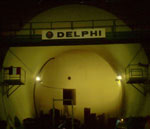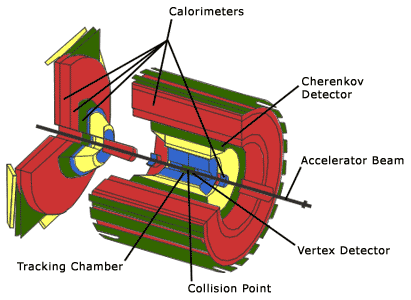|
 The door to the Delphi detector, used in the Large Electron Positron Collider.
The door to the Delphi detector, used in the Large Electron Positron Collider.
|

Most experiments at CERN involve shooting two beams of high-energy subatomic particles at each other to produce a collision, which in turn generates a spray of particles. Many of these only last a fraction of a second, leaving trails that physicists interpret. That’s why researchers must depend on extraordinarily complex, precise, and sensitive equipment called detectors to help them see the tiniest building blocks of our universe.
Often the size of a two story building, a detector can weigh as much as 4,000 tons. Scientists use detectors to study the collision path for clues to the particles’ identities and fundamental properties. In a detector, a series of layers surrounds the accelerator beam and collision points, and each layer captures different information about the particles.
 Hadrons seen in the Delphi detector. The more momentum a particle has, the less curved its trail will be.
Hadrons seen in the Delphi detector. The more momentum a particle has, the less curved its trail will be.
photo: CERN
|
Some detectors, called trackers, measure position; others measure energy, and are called calorimeters. Computers synthesize the data collected from each layer to reconstruct the physical properties -- such as momentum, energy, speed, and mass -- of as many of the particles produced in a collision as possible.
The innermost layer, called the vertex detector, is closest to the collision point and gives the most accurate reading of a particle’s path after it's created by the collision. From this starting point, physicists follow the path of the particle and can calculate the particle’s decay, or life span.
The next layer, called the tracking chamber, uses a magnetic field to chart the path of charged particles (like a proton or electron); the curvature of the path reveals a particle’s momentum. A particle with very high momentum leaves a relatively straight path, while one with low momentum leaves small spirals.
The middle layer in some detectors is the Cherenkov detector, so-called because it measures Cherenkov radiation (emitted when charged particles pass through the detector at a velocity greater than the velocity at which light can pass through the detector). This tells physicists a particle’s velocity.
These layers are arranged according to how much they destroy a particle as it
passes through. The vertex detector does the least damage
and the calorimeter, which measures the energy of the particle,
does the most. By the time the particle reaches the calorimeter,
the detector has collected all the other measurements physicists
need, except its energy. The calorimeter must be the last
detector because it measures a particle's energy by completely
absorbing it.
 Diagram of a detector
Diagram of a detector
|
|